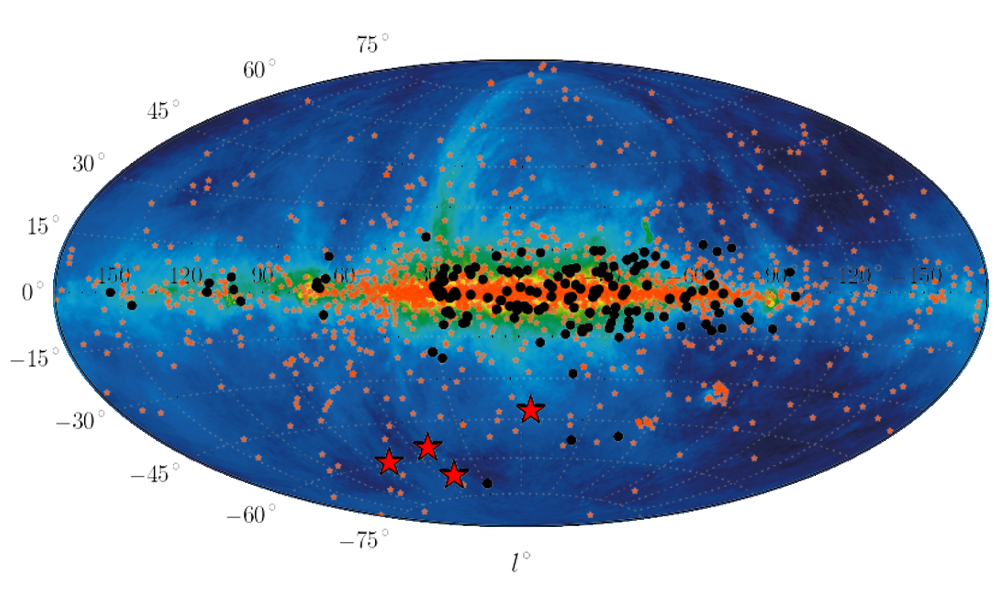Mysterious Deep-Space Explosions Baffle Scientists

Powerful and puzzling radio blasts in other galaxies constantly explode across the night sky, a new study suggests.
A team of international astronomers has detected four explosive events, known as fast radio bursts (FRBs), above the plane of our Milky Way Galaxy. Lasting only a few thousandths of a second, these sources send powerful signals across the universe, traveling billions of light-years through space.
"These bursts gave off more energy in a millisecond than the sun does in 300,000 years," said principal investigator Dan Thornton of the University of Manchester in England. [Slideshow: History & Structure of the Universe Explained]
Mysterious origins
Studying observations by the CSIRO Parkes radio telescope in Australia, Thornton and his team spotted four new point sources across the sky. The bursts ranged from 5.5 to 10 billion light-years away, meaning it took the light from some of them 10 billion years to reach Earth. (The Big Bang that created our universe occurred 13.8 billion years ago.).
These newfound objects allowed the researchers to calculate that an FRB should occur once every 10 seconds.
After the astronomers verified that the objects weren't Earth-based, they questioned whether the new signals came from inside or outside the Milky Way. To do so, they studied how the radio waves were affected by the material they pass through — a technique that could allow these new objects to shed light on the components of space.
Get the Space.com Newsletter
Breaking space news, the latest updates on rocket launches, skywatching events and more!

As radio waves travel in space, they are stretched and slowed by the ionized material through which they move. Using models, the team concluded that the FRBs traveled billions of light-years — much farther than the edge of Earth's galaxy.
"These are extragalactic in origin — not from the Milky Way — but the source is likely located in another galaxy," Thornton said.
Although the explosions are brief, the astronomers can pinpoint the bursts' locations pretty accurately.
"They are so bright and narrow that we can limit the size of the emission region at the source to just a few hundred kilometers," Thornton said.
No corresponding object could be observed in optical, gamma or X-ray wavelengths, so the explosions' origins remain unknown to scientists.
"Other variable extragalactic radio sources vary on timescales of days to months," Thornton said. "FRBs happen in just a few milliseconds."
Possible sources include intersecting magnetic fields from two neutron stars, extremely dense city-size bodies packing the mass of the sun. A special kind of supernova orbited by a neutron star could potentially produce radio bursts as the star's magnetic field interacts with the explosion of the supernova, though such combinations would be rare, researchers said.
"Our favorite explanation is a giant burst from a magnetar, a highly magnetized type of neutron star," Thornton said.
These bursts of radiation can produce an enormous amount of energy, similar to that seen in the FRBs.

Hard to spot
Although frequent, an FRB's short signal duration makes it difficult to spot.
"The problem with searching for FRBs is that we don't know where or when they will go off," Thornton said.
A single fast radio burst was detected in 2007, leaving scientists puzzled about its source, and even its existence. For the last four years, Thornton and his team have used the High Time Resolution Survey to search for similar bursts. Powered by the 210-foot (64 meters) CSIRO Parkes radio telescope, the survey was designed to search above and below the plane of the Milky Way for objects such as rotating neutron stars known as pulsars.
The Parkes telescope essentially "stares" at a region of the sky for a set amount of time, making it ideal to capture FRBs.
"At some point, one will go off in the field of view of the telescope," Thornton said.
The four new sources appeared above the plane of the galaxy. Follow-up observations, performed approximately a year after the FRBs were first spotted, looked at whether the objects continued to produce emission, but the signals appear to be nonrepeating.
"It is, of course, possible that repetitions were missed, particularly if they happened soon after the original FRB," Thornton said.
"Efforts are ongoing at the moment to detect FRBs in close to real time, such that they can be followed up quickly," he added. Ideally, such follow-up observations would be performed at a multitude of wavelengths, providing further insight into what drives these powerful explosions.
The research, along with a companion Perspectives article by James Cordes of Cornell University in New York, was published online Thursday (July 4) in the journal Science.
Follow us @Spacedotcom, Facebook or Google+. Originally published on SPACE.com.
Join our Space Forums to keep talking space on the latest missions, night sky and more! And if you have a news tip, correction or comment, let us know at: community@space.com.

Nola Taylor Tillman is a contributing writer for Space.com. She loves all things space and astronomy-related, and always wants to learn more. She has a Bachelor's degree in English and Astrophysics from Agnes Scott College and served as an intern at Sky & Telescope magazine. She loves to speak to groups on astronomy-related subjects. She lives with her husband in Atlanta, Georgia. Follow her on Bluesky at @astrowriter.social.bluesky
